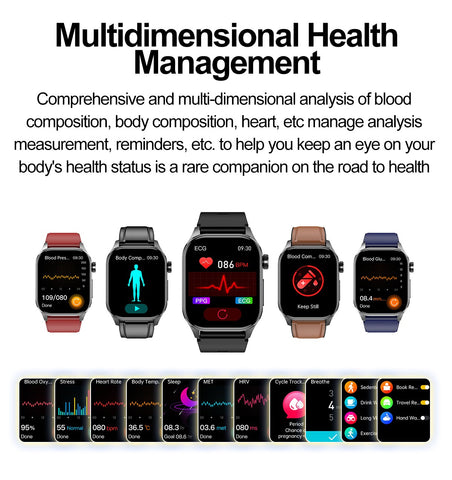What is Zone 2 Aerobic Training?
Not long ago, High-Intensity Interval Training (HIIT) reigned supreme in the fitness world. However, now this intense and demanding form of exercise may need to share the spotlight with a more moderate and sustainable training approach known as Zone 2 training. This method is gaining popularity among runners, fitness enthusiasts, and everyday exercisers alike. During these workouts, the focus is often on exercises targeting the legs, arms, and core muscles.
But there's one area you might be overlooking, which could be your best fitness guide—the heart beating in your chest. Increasingly, research suggests that this organ might be the best gauge of your workout intensity.
While there are various aerobic exercise methods, Zone 2 aerobic training can enhance your aerobic fitness and endurance with relatively low stress on the body. In practice, this could be a sustained, rhythmic jog or a leisurely long-distance bike ride.

What Exactly is Zone 2 Aerobic Training?
Zone 2 aerobic training is one of five heart rate zones, with Zone 5 being the highest and Zone 1 the lowest. Zone 2 occurs at 60% to 70% of maximum heart rate and is characterized by low-intensity, foundational endurance training without interval workouts. This training style is slow and steady, allowing you to maintain it for extended periods, even engaging in light conversation or humming while exercising.
Zone 2 training, also known as "base training," forms a significant portion or foundation of your weekly exercise regimen. For endurance athletes, training plans typically emphasize Zone 2 and Zone 3, comprising 60% to 75% of training time.
Benefits of Zone 2 Aerobic Training
At this point, you might think that only high-intensity exercises maximize cardiovascular health and endurance. This common misconception could lead to overexertion during activities like cycling, running, or other aerobic exercises. However, the surprising benefits of slower-paced training include:
-
Enhanced Recovery: A 2022 study found that a single session of Zone 2 training can increase blood flow without adding muscle inflammation or damage, thereby accelerating muscle repair.
-
Improved Cardiovascular Health: Aerobic training improves cardiovascular health, reducing mortality and disease rates while extending lifespan. It also lowers the risk of common cardiovascular diseases such as atherosclerosis, which can lead to hypertension, stroke, and heart disease.
-
Enhanced Mental Well-being: A 2019 study discovered that aerobic exercise enhances self-esteem and social skills while reducing anxiety, depression, and insomnia.
-
Injury Prevention: Zone 2 aerobic training imposes less strain on joints and muscles, aiding in injury prevention. Daily high-intensity interval training can unnecessarily stress joints, increasing the risk of injury. Whether you engage in endurance or high-intensity interval training, Zone 2 training should serve as a foundation.
-
Sustainability: Because Zone 2 aerobic training doesn’t leave you feeling exhausted, it’s easier to maintain regular exercise habits. Research shows that those who find exercise enjoyable are more likely to continue.

Introduction to Heart Rate Zones
Now, let’s delve into how to calculate your Zone 2 heart rate. Don’t worry; it’s much simpler than your high school algebra class. First, you need to calculate your maximum heart rate.
How to Calculate Maximum Heart Rate: Subtract your age from 220 to determine your maximum heart rate (MHR). For example, a 30-year-old would have a maximum heart rate of 190 beats per minute (bpm). With this figure, you can calculate your heart rate zones.
Determining Heart Rate Zones: Zone 1 heart rate is 50% to 60% of MHR, and Zone 2 heart rate is 60% to 70% of MHR. This is a comfortable effort level that allows for sustained effort without feeling strained or breathless. In this state, your body uses both glucose and oxygen as energy sources, such as jogging on a treadmill or enjoying a pleasant bike ride with friends.
Getting Started with Zone 2 Training
Zone 2 training should comprise the majority of your workout time—approximately 60% to 75%. For beginners, starting with Zone 2 and Zone 3 training and gradually building aerobic capacity is beneficial. Such training avoids mental and physical stress.
Importance of Heart Rate Monitoring During Training
Wearing a heart rate monitor during training is crucial for accurately monitoring your effort zone. It allows you to check in real-time whether you're within the recommended range and helps adjust your pace to stay within the upper and lower limits of Zone 2. It's a vital tool for balancing endurance effort and maintaining optimal aerobic exercise.
Conclusion
Zone 2 aerobic training has gained popularity as a method in recent years. However, we should neither overestimate its benefits nor overlook its limitations.
On one hand, regular training in Zone 2 can lead to genuine improvements in cardiovascular and metabolic health, even if moderately. This contributes to long-term health maintenance. Therefore, Zone 2 remains of interest for integrating into various programs.
On the other hand, this training method should not be idealized or considered a cure-all. Its benefits are limited, and other methods like HIIT have largely proven themselves. Most importantly, Zone 2 should not become a constraint or lead to neglecting other intensity zones, which are crucial for optimal adaptation.








